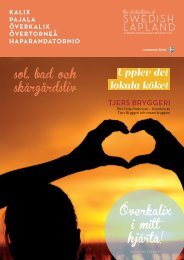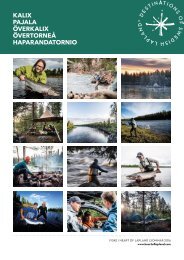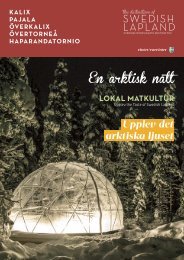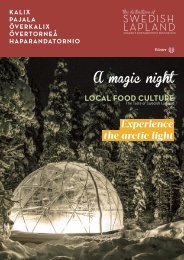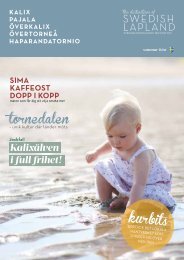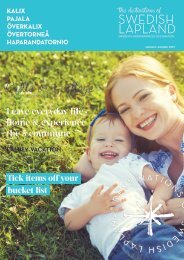Heart of Lapland, summer 2016
Create successful ePaper yourself
Turn your PDF publications into a flip-book with our unique Google optimized e-Paper software.
Culture<br />
EASTERN SWEDISH LAPLAND – A COLOURFUL REGION<br />
i t’s a colo u r f u l re g i o n, east e r n sw e d i s h<br />
l a p l a n d. Perhaps that has to do with the fact that<br />
in days gone by the populations <strong>of</strong> the two river<br />
valleys were isolated, each on its own side <strong>of</strong> the<br />
mountain crest separating them. In those days the<br />
rivers were the transportation channels in both<br />
<strong>summer</strong> and winter and the obvious pantry year<br />
round. Settlements and villages grew up around the<br />
rivers, subsequently developing into meeting places<br />
and communities. Completely different languages<br />
have developed along both <strong>of</strong> the river valleys.<br />
By the river Kalix River, in Överkalix, Överkalixbondskan<br />
is one <strong>of</strong> the country’s most distinctive<br />
dialects. It differs markedly from the dialect spoken<br />
in the neighbouring municipality <strong>of</strong> Kalix. And in<br />
Tornedalen, Torne River Valley, a minority language<br />
known as Meänkieli, or “Torne Valley Finnish”,<br />
is spoken. It is closely related to Finnish. That’s<br />
fascinating, considering that only a few kilometres<br />
separate the two valleys. And in addition to these<br />
three languages, Swedish, Finnish and Sami also<br />
are spoken in the region. The border culture has<br />
many different aspects, and at Tornedalen Museum<br />
you can learn more about all <strong>of</strong> the dramatic<br />
historical events that have left their stamp on life in<br />
the area.<br />
The churches in eastern Swedish <strong>Lapland</strong> are<br />
unquestionably worth a tour <strong>of</strong> their very own. The<br />
Photo: Fredrik Broman<br />
church in Kalix is, in fact, Sweden’s northernmost<br />
medieval church. In the Övertorneå church you can<br />
see and listen to Sweden’s oldest organ. And you<br />
will clearly see that the region has had, and continues<br />
to have, exchan- ges in an east-west direction<br />
when you visit the orthodox churches in Överkalix<br />
and Haparanda. Sauna culture is something <strong>of</strong> a<br />
religion <strong>of</strong> its own for eastern Swedish <strong>Lapland</strong>.<br />
Those who believed that there is only one way to<br />
bathe in a sauna have a lot to explore with us. Try<br />
your hand at distinguishing between an electric<br />
and wood-fired sauna, between a smoke sauna and<br />
a steam sauna. And don’t miss allowing the whisk<br />
<strong>of</strong> birch twigs to bring your skin back to life in the<br />
heat. Now that you are here in winter, it’s obligatory<br />
to jump right out in the snow, directly from<br />
the sauna without a stitch <strong>of</strong> clothing. Guaranteed<br />
rejuvenation.<br />
The handicrafts culture is strong, and the<br />
region’s very own hallmark is genuine and wellmade<br />
products <strong>of</strong> the highest quality. Look for<br />
Made in Kalix products and Kero’s supreme leather<br />
crafts in Sattajärvi. Or visit Simu Nordic in Övertorneå.<br />
Many tourist <strong>of</strong>fices in the area sell local crafts<br />
and can tell you more about the many skilled artisans.<br />
Welcome to an exploration <strong>of</strong> the boundlessly<br />
interesting culture in eastern Swedish <strong>Lapland</strong>.<br />
Photo: Lulebild AB/Michael Törnqvist<br />
Photo: Linda Vuollo<br />
Kukkolaforsen - The kingdom<br />
<strong>of</strong> saunas and whitefish<br />
The locals <strong>of</strong> Kukkolaforsen are immensely proud <strong>of</strong> their history<br />
and culture. Join a guided tour through the beautiful village<br />
with its Fishing Museum and Sauna Museum. You’ll discover<br />
how the locals worked around and in the river over 500 years<br />
ago and still do (some fishing methods have actually stayed<br />
the same!). www.kukkolaforsen.se<br />
Unique whitefish fishing with net<br />
Whitefish fishing in Kukkolaforsen is like no other fishing<br />
experience. The method used here originates from the 16th<br />
century and involves a net with a long shaft. This method is also<br />
unique from a geographical point <strong>of</strong> view – it’s only used in the<br />
Amazon River in Brazil and here in eastern Norrbotten! This<br />
method is normally used from the beginning <strong>of</strong> June through to<br />
mid-September.<br />
Fancy trying this unique fishing method? At Kukkolaforsen Turist<br />
& Konferens guests are <strong>of</strong>fered the opportunity to try this unique<br />
fishing experience. Net, fishing and instructor are catered for.<br />
Plus, you’ll get to keep all fish you catch during the hour!<br />
Though, you don’t need to fish yourself to be able to enjoy<br />
exquisite flavours. In the restaurant you can order various dishes<br />
prepared from local produce and fish caught in the area. How<br />
about grilled whitefish in herbal sauce or a roasted salmon?<br />
Be inspired by true<br />
craftsmanship<br />
The KERO company has a long and solid history. Yrjö Kero<br />
founded the company in 1929 together with Karl Wälivaara<br />
and made it his life’s mission to create the thriving company<br />
that developed into the still-thriving company culture in the<br />
small village <strong>of</strong> Sattajärvi, 20 kilometres south <strong>of</strong> Pajala in<br />
Sweden’s far north. At KERO’s you can buy everything from<br />
c<strong>of</strong>fee bags and backpacks to knives and shoes , all made with<br />
care and love. www.kero.se<br />
The man who’s all about<br />
saunas<br />
It’s safe to say that what Svante Spolander doesn’t know<br />
about saunas, isn’t worth knowing. He was born and raised<br />
in Kukkola in the central parts <strong>of</strong> Torne Valley. Here the<br />
sauna is a natural part <strong>of</strong> everyday life; the place where life<br />
begins, where life goes on and where life ends.<br />
- I use the sauna every day, it’s my life elixir. There I get to<br />
enjoy some peace and quiet for myself and get a chance to<br />
clear my head and regain energy, says Svante Spolander.<br />
In fact, one <strong>of</strong> Svante’s first childhood memories features<br />
the sauna. He recalls looking for his father and then found<br />
him and other men from the village in the public sauna.<br />
- As a little boy, at first this was a terrifying experience, all<br />
these men and the heat from the steam. The fear soon gave<br />
away for a sense <strong>of</strong> belonging that’s not very easy to explain.<br />
There in the heat, without a stitch <strong>of</strong> clothing, everyone’s<br />
the same: young or old, tall or short, Finnish or Swedish. All<br />
wrongs and arguments are left outside the sauna. The sauna is<br />
indeed a place for reconciliation and ever since that moment,<br />
the sauna has been in my heart, says Svante and puts his hand<br />
on his chest.<br />
Discover the cultural history<br />
The resident exhibition <strong>of</strong> Tornedalens Museum, ”Möten på<br />
gränsen – vår gemensamma älvdal”, tells the story <strong>of</strong> the roots<br />
<strong>of</strong> the people living here: why they have chosen this area and<br />
how they’ve lived their lives. Visit the exhibition and find out<br />
what archeological findings can tell us about the life thousands<br />
and even hundreds <strong>of</strong> thousands years ago, learn about traditional<br />
industries and the effects that war has had on the locals.<br />
The history and stories are conveyed through artefacts, pictures,<br />
sound and films. The proximity <strong>of</strong> the border and its impact<br />
is a big part <strong>of</strong> the exhibition. Other typical phenomena <strong>of</strong> the<br />
area are also represented, including cuisine, rock music, local<br />
identity, language and dialects. www.merilapinmuseot.fi/sv<br />
Photo: Pantheon<br />
Photo: Tomas Bergman<br />
WELCOME!<br />
Visit us: Sattajärvi 320, 984 92 Pajala<br />
14 DESTINATIONS OF SWEDISH LAPLAND KALIX PAJALA ÖVERKALIX ÖVERTORNEÅ HAPARANDATORNIO 15



